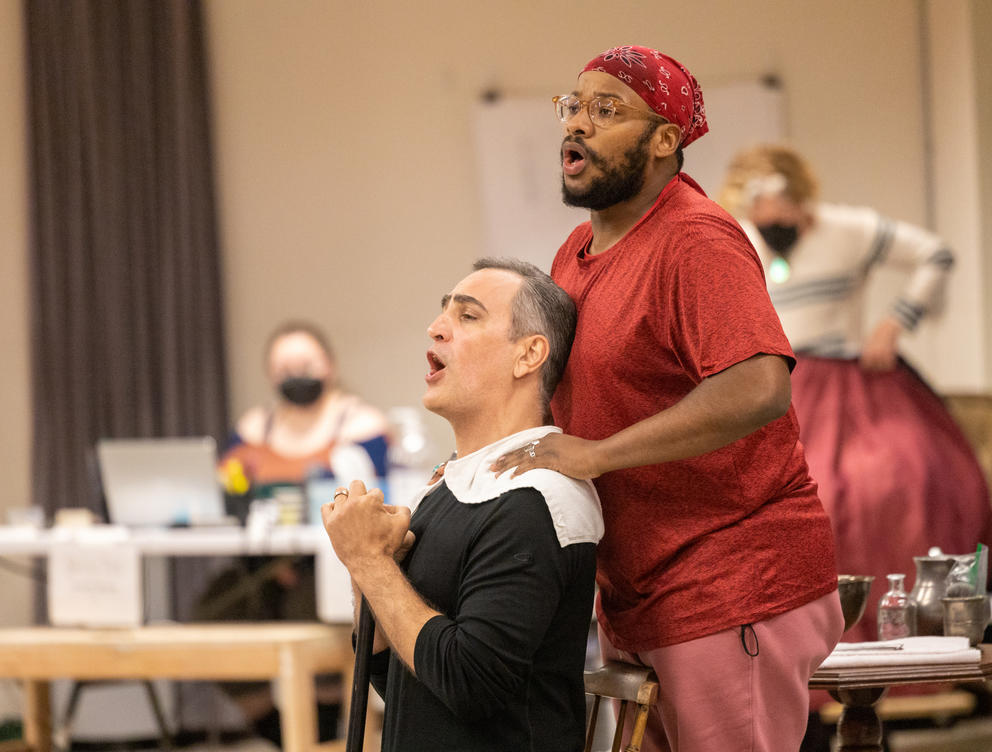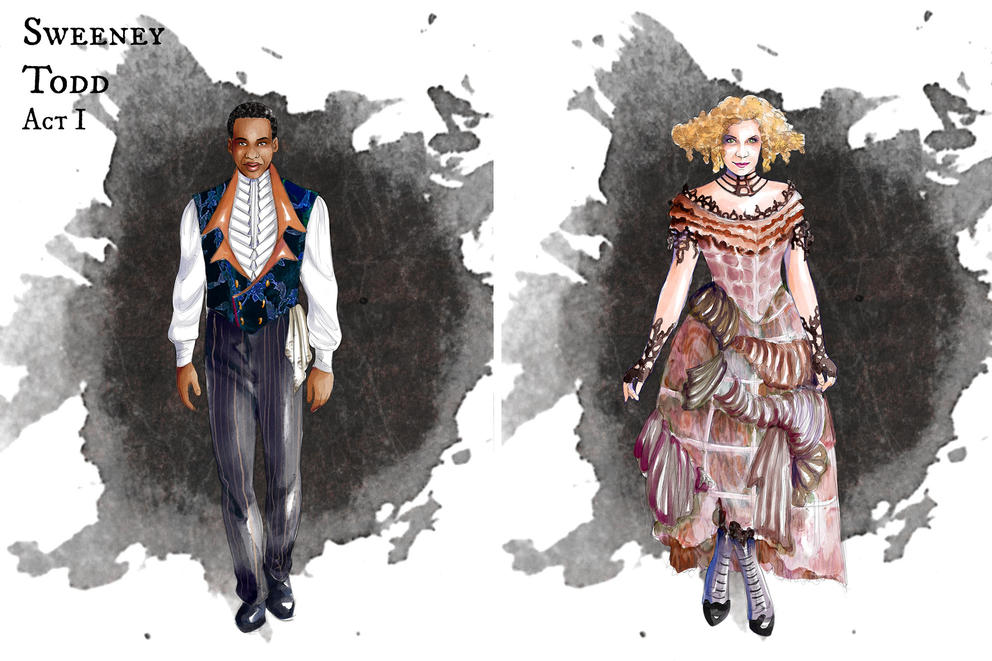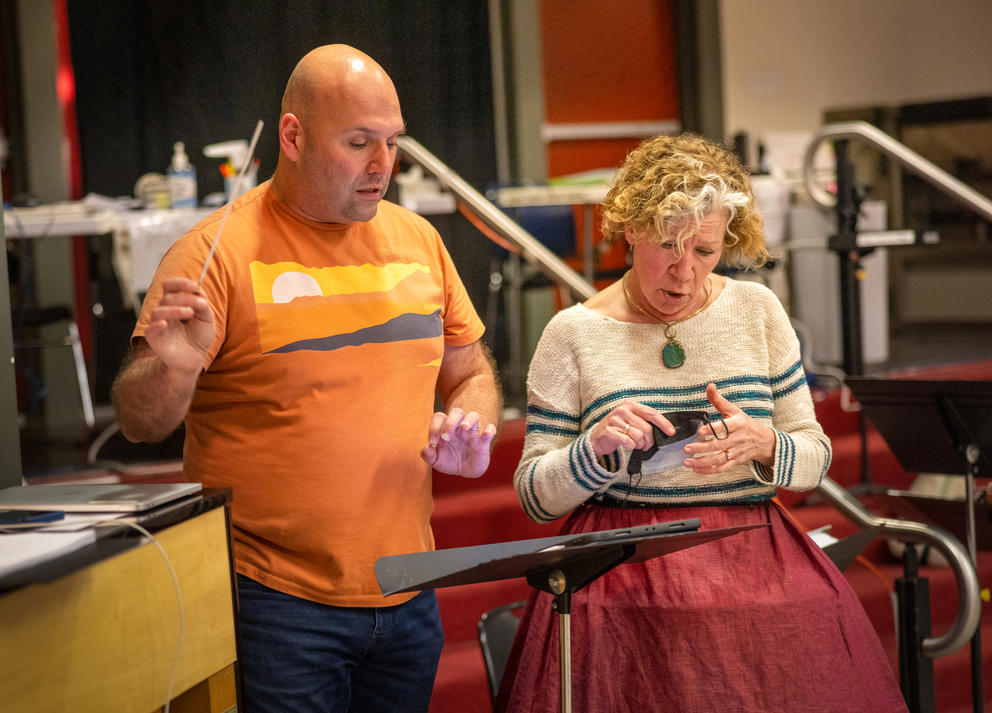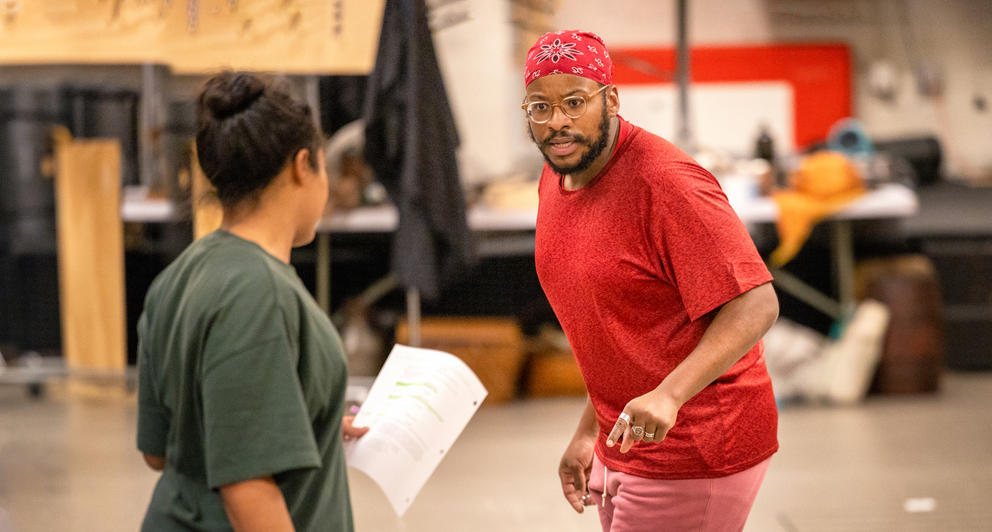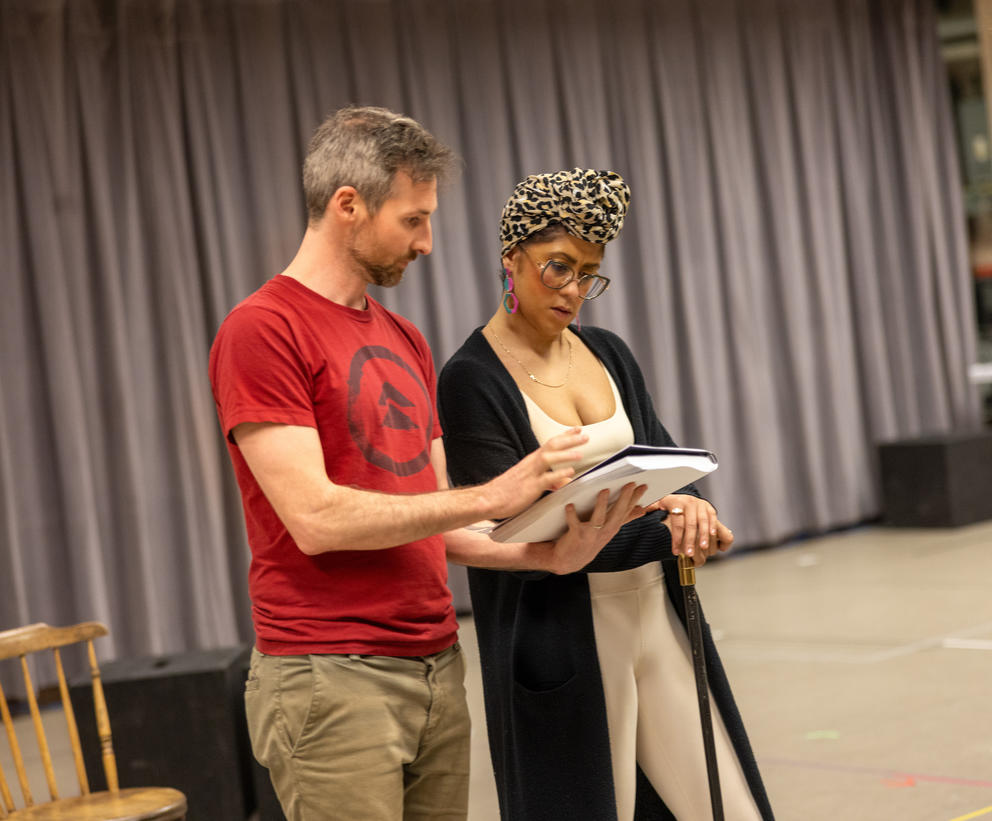The decidedly macabre, internationally popular Stephen Sondheim musical Sweeney Todd: The Demon Barber of Fleet Street was one of the celebrated composer/lyricist’s favorites among the 16 Broadway musicals he crafted. (The story, adapted from Christopher Bond’s 1970 play Sweeney Todd, is based on an old English legend.)
And to hear leading players in The 5th Avenue Theatre’s new production (running April 21 – May 14) tell it, the show, with its sweeping score, black humor and gripping plot, is an actors’ favorite as well.
But the musical comes with significant challenges for the cast.
Sondheim “was such a stickler for absolute accuracy when you do his shows,” says Anne Allgood, a seasoned Seattle actress and singer with Broadway cred. “I want to get every word and note right.” In this production she plays the 18th century Cockney widow Mrs. Lovett, who hooks up with Sweeney Todd, the brooding ex-convict with extra-sharp razors and a list of deep grudges.
Yusef Seevers, the Seattle newcomer who portrays Sweeney, agrees that appearing in the musical is rewarding. But he stresses that a performer must have “ample tools” to tackle the totemic title role “and not be threatened by it.”
Costume renderings for Sweeney Todd and Mrs. Lovett, lead characters in ‘Sweeney Todd’ at The 5th Avenue Theatre, by costume designer Danielle Nieves. (The 5th Avenue Theatre)
If the demands of the show have frightened some, many other performers have embraced them with, well, a vengeance ever since Sondheim and his collaborators (director Harold Prince, librettist Hugh Wheeler) premiered the work at Broadway’s Uris Theatre.
In the original 1979 production, film and stage actress Angela Lansbury played Mrs. Lovett opposite Len Cariou’s Sweeney. And currently the crowd-pleasing, multiplatinum singer (and self-proclaimed theater geek) Josh Groban is drawing raves on Broadway in the title role.
In Tim Burton’s popular 2007 film version of the musical, Johnny Depp plays Sweeney with bloodthirsty gusto and Helena Bonham-Carter is Mrs. Lovett.
For that especially gruesome cinematic version, songs were trimmed and the opening number — in which a Greek-style chorus commands the audience to “attend the tale of Sweeney Todd” — was dropped altogether, with Sondheim’s permission.
But at The 5th, there are no such shortcuts. The theater, under current artistic director Bill Berry as well as his predecessor David Armstrong, has long been an avid presenter of Sondheim’s canon.
One of Armstrong’s first shows after taking the helm in 2000 was A Little Night Music, a romantic earlier work by the composer/lyricist. Since then, the theater has produced (sometimes in collaboration with Seattle’s ACT Theatre) numerous others (e.g., Gypsy, Company, Sunday in the Park with George), including a Sweeney Todd staged by Armstrong in 2005.
The current outing, mounted by the 5th’s new associate artistic director Jay Woods, is the complete show with a full orchestra. But a few things have changed since the previous staging, including a less elaborate set, more diverse casting and more explicit sexuality.
The show is the second half of the theater’s two-part homage to Sondheim, who passed away at age 91 in 2021. Earlier this year, the 5th produced Into the Woods. Berry notes that he deliberately chose Sweeney Todd as a back-to-back contrast to Into the Woods, finding it an equally sophisticated but somewhat sunnier Sondheim musical based on familiar fairy tales.
In the weeks and months leading up to the opening night of Sweeney, Allgood has been, as she puts it, “in training” for the production. “Since the beginning of the year I’ve been building up a lot of little microscopic sets of muscles for the role, like an athlete does to run a race.”
What exactly makes this show, and much of Sondheim’s output, so challenging for the cast?
First of all, the lyrics. In Sweeney Todd especially, the composer was known for tightly packing his tunes with loads of words that must be crisply articulated at a fast tempo. (Trying singing “Bus'ness never better using only pussycats and toast!” three times fast.)
“He was such an amazingly gifted lyricist,” says Allgood, who logged several performances as Mrs. Lovett for Portland Opera in 2016. “If you don’t feel and actively interpret the lyrics, they can just be the cleverest tongue-twisters in the world.”
Adding emotion is particularly difficult in a witty patter song like “The Worst Pies in London.” It occurs early in the show, when Sweeney (fresh off the boat after being falsely imprisoned for 15 years) visits his former London home, which now houses the widowed Mrs. Lovett’s failing meat-pie shop.
While cozying up to Sweeney, Mrs. Lovett bemoans her product at breakneck pace (“Only lard and nothing more/Is that just revolting/All greasy and gritty?”) while also vigorously kneading pie dough.
“There are a lot of clues to who this person is in the song, because there are some very brassy, percussive phrases. Then all of a sudden it gets lyrical and beautiful, and she’s playing the martyr — oh poor me,” explains Allgood. “I’m pounding the dough, and switching between singing and pounding,” she adds with a laugh.
In the big solo number “Epiphany,” Seevers as Sweeney must deliver a torrent of meaningful lyrics across shifting tempos, after one of the corrupt men he aims to get even with for destroying his wife and daughter escapes the barber’s wrath. “And I will get him back even as he gloats/In the meantime I'll practice on less honorable throats …” one of the faster passages begins.
As the music drives the tune apace, “My body wants to stop, stop, stop, but Sweeney cannot stop,” says Seevers. “I think most of my work is getting out of my own way. I just have to get the song revved up and going. I can’t pull the emergency brake!”
On top of the sheer velocity required, the score poses an additional layer of difficulty: Mrs. Lovett and Sweeney must at times sing clashing phrases of two different melodies in two different rhythms.
A big concern in these numbers (which are, don’t worry, interspersed with some less hectic, quite lovely ballads for various characters, like “Not While I’m Around” and “Johanna”) is physical: drawing in enough air. As Angela Lansbury once half-joked, Sondheim forgot to write in places where she could breathe.
The audience should never see a vocalist gasp for breath in mid-song. That’s where the magic of training, experience and preparation comes in.
“If you saw my score, which I always keep close at hand, you’d see I’ve written breathe! Breathe! Breathe! all over it,” says Allgood, who has studied and now teaches singing technique. “I use the inhalations as a chance to relax, reset, refuel, even if they are very quick.”
Seevers, a Detroit native and classically trained singer schooled in breathwork, has advice too.
“What is the most effective and swift way to create air? The way you learn that is before you get here,” he says. “If you’re doing [Sweeney] five, six, seven times a week for more than a week? You can wing it, but by performance number 13 you’ll need more than wings to get you through this two-hour-plus musical.”
It helps to be accustomed to the Bard of Avon’s verse as well, says Berry. “People who have used a lot of language [on stage] before, people well-versed in Shakespeare, can often do Sondheim more easily.” (Not surprisingly, both Allgood and Seevers, as well as some other cast members, have performed in Shakespeare plays.)
Another, less technical challenge is conveying the complexity of the characters amid all these words. As usual in Sondheim shows, even the nefarious — and Sweeney is perhaps his most nefarious character — provide reasons for us to pity them, or at least comprehend what drives them.
“You don’t get to see what happened 15 years before the play begins, but everything you hear about it and everything you see is contextualized by those 15 years,” suggests Seevers. “Can we hold this person responsible for his actions without understanding what his background is?”
Because Sweeney’s fury is either barely contained or erupting throughout the musical, “Jay and I talked about how easy it would be to fall into the trap of just having [Seevers] be angry and raging all the time,” artistic director Berry says.
“So how does Sweeney become a human being to us, not just a monster?” Berry posits. “I think Sondheim is asking us to consider what happens when someone is pushed to the brink and feels they have no more options.”
Even Mrs. Lovett, an eager accomplice to Sweeney’s misdeeds, evokes more than laughter and scorn, according to Allgood. “There’s more to these people than first meets the eye,” she says. “The driving thing for Mrs. Lovett is that she’s lonely, and she desperately wants love, and safety, and financial security. She believes Sweeney can give her that.”
When it comes to the central characters in Sweeney Todd, you could wind up loathing them or empathizing with them or both. And it is not just up to the actors how you react, but also the director and the production team and Sondheim himself — not to mention your own predilections.
But these Seattle actors will be doing their best to rise to Sondheim’s exacting mandates, while at the same time making the audience laugh, gasp and care.
Get the latest in local arts and culture
This weekly newsletter brings arts news and cultural events straight to your inbox.

